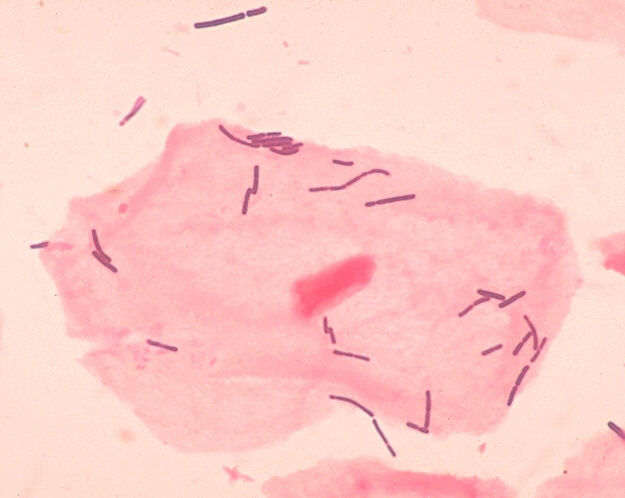Lactobacillus
| Lactobacillus | ||||||||||||
|---|---|---|---|---|---|---|---|---|---|---|---|---|
 Lactobacillus bacteria (around vaginal squamous epithelial cells)
| ||||||||||||
| Scientific classification | ||||||||||||
| ||||||||||||
| Species | ||||||||||||
|
L. acidophilus |
Editor-In-Chief: C. Michael Gibson, M.S., M.D. [1]
Overview
Lactobacillus is a genus of Gram-positive facultative anaerobic bacteria. They are a major part of the lactic acid bacteria group, named as such because most of its members convert lactose and other sugars to lactic acid. They are common and usually benign. In humans they are present in the vagina and the gastrointestinal tract, where they are symbiotic and make up a small portion of the gut flora. Many species are prominent in decaying plant material. The production of lactic acid makes its environment acidic which inhibits the growth of some harmful bacteria. Several members of the genus have had their genome sequenced.
Food production
Some Lactobacillus species are used industrially for the production of yogurt, cheese, sauerkraut, pickles, beer, wine, cider, kimchi and other fermented foods, as well as animal feeds, such as silage. Sourdough bread is made using a "starter culture" which is a symbiotic culture of yeast and lactic acid bacteria growing in a water and flour medium. Lactobacilli, especially L. casei and L. brevis, are some of the most common beer spoilage organisms. The species operate by lowering the pH of the fermenting substance by creating the lactic acid, neutralising it to the desired extent.
Dental cavities
Although considered beneficial, some Lactobacillus species have been associated with dental caries. [2] Lactobacillus count in saliva has been used as a "caries test" for many years. [3] This is one of the arguments used in support of the use of fluoride in toothpaste and lozenges. [4]
Metabolism
Many lactobacilli are unusual in that they operate using homofermentative metabolism (that is, they produce only lactic acid from sugars) and are aerotolerant despite the complete absence of a respiratory chain. This aerotolerance is manganese-dependent and has been explored (and explained) in Lactobacillus plantarum. Many lactobacilli do not require iron for growth and have an extremely high hydrogen peroxide tolerance.
According to metabolism, Lactobacillus species can be divided into three groups:
- Obligately homofermentative (Group I)
- Facultatively heterofermentative (Group II)
- Obligately heterofermentative (Group III)
Treatment
Antimicrobial regimen
- 1. Endovascular Infection [1]
- Preferred regiemn (1): Penicillin G 20 MU/day for 6 weeks
- Preferred regiemn (2): Gentamicin 1.3 mg/kg IV q8h (trough <1.5 mg/L) AND Polychlorinated naphthalene
- 2. Odontogenic Infection
- Preferred regiemn: Clindamycin 450 mg PO qid
- 3. Intrabdominal Abscess
- Preferred regiemn: Clindamycin 450 mg PO qid
References
- ↑ Bartlett, John (2012). Johns Hopkins ABX guide : diagnosis and treatment of infectious diseases. Burlington, MA: Jones and Bartlett Learning. ISBN 978-1449625580.
References
- Tomas James Rees, Cranfield University, 1997. The development of a novel antifungal silage inoculant. PhD Thesis (HTML)
- The Ohio State University Food Science and Technology Department. Lactic Acid Bacteria - Carbohydrate and Protein Metabolism. PowerPoint lecture
- Dicks LM, Silvester M, Lawson PA, Collins MD (2000). Lactobacillus fornicalis sp. nov., isolated from the posterior fornix of the human vagina. Abstract, PDF file